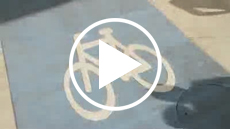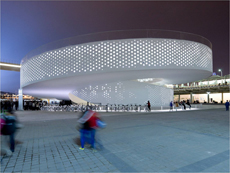| Denmark Pavilion |
 |
Photos courtesy of BIG.
 |
 |
 |
 |
| Theme: Welfairytales |
Client: Danish Enterprise & Construction Authority, Expo 2010 |
| Size: 9,842 square feet |
Design: BIG |
Click On Photos For
More Info


 |
Exterior Design: Conceived as a giant self-supporting truss and constructed of white-painted steel, Denmark’s pavilion resembles a white Slinky. Thousands of perforations of varying size along the metal skin help ventilate and light the interior, while LEDs placed in each of the 3,500 openings transform the face from austere metal coils by day into a colorful work of abstract art by night. Form follows function, however, as the pavilion’s elliptical shape houses a giant velodrome, where 1,500 bikes are available for attendees to glide from the pavilion’s base to its cloud-white roof.
Pavilion Summary: Based on the concept of “welfairytales” — a blending of “welfare” and “fairy tales” — Hans Christian Andersen’s native country authors a new fairytale for an ecology-minded era. The centerpiece of the pavilion is the statue of the Little Mermaid, which was brought to Shanghai from its home in the Copenhagen harbor where it has sat since it was unveiled in 1913. Denmark also shipped a supertanker full of water from the harbor — where, after years of rank pollution, Danes can now swim, thanks to various Green efforts. The statue and water form the pavilion’s Harbour Pool, whose soft aqua lighting illuminates the ground floor as well as the VIP area below it.
Coursing from the exterior all the way to its top is a “social bench” designed by Danish artist Jeppe Hein. Made of white steel, it functions as a resting place and as a barrier between pedestrians and cyclists, who can bike on a blue-epoxy path from the pavilion’s base to its cloud-white roof. While bikers wheel around, visitors can take in the trio of presentations: “Tales of how we live,” “Tales of what we love,” and “Tales of where we’re going.” In “Live,” Danish director Martin de Thurah shows how the average Dane’s lifestyle is centered on sustainability, while in “Love,” photographer Peter Funch’s pictures spin stories of Danish people’s lives. “Going” completes the trilogy, illustrating how Danish-Chinese cooperation can improve city life. Their minds nourished, attendees can sustain the rest of themselves by biking or hiking to the roof, where a café serves traditional Danish foods in picnic baskets.
|
| |
| Top of Page |
|
|
